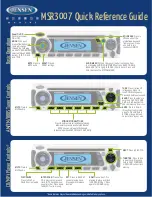
Mounting
Secure the Triton™ Edge™ vertically, with its cable exits facing down. To allow access to the cables, ensure there is at
least 15 cm (5.9’’) of clearance between the connectors and the surface underneath them. Installation in an engine
compartment is
not
recommended because the environment is hot and electrically noisy.
To prevent interference between the unit and the vessel’s compass(es), ensure the unit is at least 50 cm (20’’) away from
any compass.
It may be helpful to check the strength of the unit’s Wi-Fi
®
signal at different locations on the vessel before choosing its
permanent position.
Mark the hole positions (
1
), drill pilot holes (
2
); and fix the sailing processor into position with the four supplied self-
tapping screws (
3
).
¼
CAUTION:
Always wear appropriate eyewear, ear protection and dust mask when drilling, cutting, or sanding.
Remember to check the reverse side of all surfaces whenever drilling or cutting.
1
2
3
Connecting the Triton™ Edge™
E
H
G
F
A
B
C
D
Earth-ground connection point (B)
Your vessel may accumulate static charge through friction with the air. To prevent a damaging discharge through the
NMEA 2000
®
network, use a conducting wire to connect the Earth-ground connection point (
B
) on the Triton™ Edge™
to a point on the hull that is in electrical contact with the water. This will ground the unit and network via a bleed path,
allowing excess charge to dissipate safely. This precaution is recommended if you are using a wired NMEA 2000
®
wind
sensor or mast head unit, however, may not be required for a wireless wind sensor.
Power (A)
The unit is designed to be powered by a 12 V or 24 V DC
source. A 1 A fuse, or circuit breaker, should be fitted to the
positive terminal of the power supply.
Connect the red and black wires in the power cable to
the positive and negative terminals of the power supply,
respectively.
The blue and yellow wires are not used. Wrap their ends with
insulating tape to prevent short circuits.
Connectors
A
Power
B
Earth-ground connection point
C
NMEA 2000
®
D
Ethernet
Status LEDs
E
Power (steady green when powered. Red
when restarting)
F
NMEA 2000
®
(rapid flicker on data transfer)
G
Ethernet (rapid flicker on data transfer)
H
Wi-Fi
®
(steady blue when hotspot is on)
1
3 4
2
6
5
Power cable
1.
12/24 V DC (red)
2.
Ground/negative
(black)
3.
Not used (blue)
4.
Not used (yellow)
5.
Switch
6.
Fuse






















